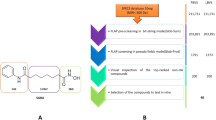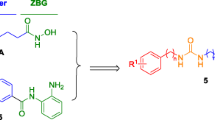Abstract
Aspirin is one of the oldest drugs for the treatment of inflammation, fever, and pain. It is reported to covalently modify COX-2 enzyme by acetylating a serine amino acid residue. By virtue of aspirin’s acetylating potential, we for the first time developed novel acetyl-donating HDAC inhibitors. In this study, we report the design, synthesis, in silico docking study, and biological evaluation of acetyl-donating HDAC inhibitors. The exposure of MDA-MB-231 cells with compound 4c significantly promotes the acetylation of α-tubulin and histone H3, which are substrates of HDAC6 and HDAC1, respectively. In silico docking simulation also indicates that compound 4c tightly binds to the deep substrate-binding pocket of HDAC6 by coordinating the active zinc ion in a bidentate manner and forming hydrogen bond interactions with Ser531 and His573 amino acid residues. In particular, compound 4c (GI50 = 147 μM) affords the significant enhancement of anti-proliferative effect on MDA-MB-231 cells, compared with its parent compound 2c (GI50 > 1000 μM) and acetyl-donating group deficient compound 6 (GI50 = 554 μM). Overall, compound 4c presents a novel strategy for developing acetyl-donating HDAC inhibitors.







Similar content being viewed by others
References
Bassett SA, Barnett MP (2014) The role of dietary histone deacetylases (HDACs) inhibitors in health and disease. Nutrients 6:4273–4301
Bolden JE, Peart MJ, Johnstone RW (2006) Anticancer activities of histone deacetylase inhibitors. Nat Rev Drug Discov 5:769–784
Chun P (2018) Therapeutic effects of histone deacetylase inhibitors on kidney disease. Arch Pharm Res 41:162–183
Cuadrado-Tejedor M, Garcia-Barroso C, Sanchez-Arias JA, Rabal O, Perez-Gonzalez M, Mederos S, Ugarte A, Franco R, Segura V, Perea G, Oyarzabal J, Garcia-Osta A (2017) A first-in-class small-molecule that acts as a dual inhibitor of HDAC and PDE5 and that rescues hippocampal synaptic impairment in Alzheimer’s disease mice. Neuropsychopharmacology 42:524–539
D’ydewalle C, Bogaert E, Van Den Bosch L (2012) HDAC6 at the intersection of neuroprotection and neurodegeneration. Traffic 13:771–779
Duvic M, Talpur R, Ni X, Zhang C, Hazarika P, Kelly C, Chiao JH, Reilly JF, Ricker JL, Richon VM, Frankel SR (2007) Phase 2 trial of oral vorinostat (suberoylanilide hydroxamic acid, SAHA) for refractory cutaneous T-cell lymphoma (CTCL). Blood 109:31–39
Glozak MA, Sengupta N, Zhang X, Seto E (2005) Acetylation and deacetylation of non-histone proteins. Gene 363:15–23
Golden SA, Christoffel DJ, Heshmati M, Hodes GE, Magida J, Davis K, Cahill ME, Dias C, Ribeiro E, Ables JL, Kennedy PJ, Robison AJ, Gonzalez-Maeso J, Neve RL, Turecki G, Ghose S, Tamminga CA, Russo SJ (2013) Epigenetic regulation of RAC1 induces synaptic remodeling in stress disorders and depression. Nat Med 19:337–344
Hawkins D, Pinckard RN, Crawford IP, Farr RS (1969) Structural changes in human serum albumin induced by ingestion of acetylsalicylic acid. J Clin Invest 48:536–542
Hong L, Schroth GP, Matthews HR, Yau P, Bradbury EM (1993) Studies of the DNA binding properties of histone H4 amino terminus. Thermal denaturation studies reveal that acetylation markedly reduces the binding constant of the H4 “tail” to DNA. J Biol Chem 268:305–314
Hrast M, Anderluh M, Knez D, Randall CP, Barreteau H, O’neill AJ, Blanot D, Gobec S (2014) Design, synthesis and evaluation of second generation MurF inhibitors based on a cyanothiophene scaffold. Eur J Med Chem 73:83–96
Kazantsev AG, Thompson LM (2008) Therapeutic application of histone deacetylase inhibitors for central nervous system disorders. Nat Rev Drug Discov 7:854–868
Lee DY, Hayes JJ, Pruss D, Wolffe AP (1993) A positive role for histone acetylation in transcription factor access to nucleosomal DNA. Cell 72:73–84
Lee HZ, Kwitkowski VE, Del Valle PL, Ricci MS, Saber H, Habtemariam BA, Bullock J, Bloomquist E, Li Shen Y, Chen XH, Brown J, Mehrotra N, Dorff S, Charlab R, Kane RC, Kaminskas E, Justice R, Farrell AT, Pazdur R (2015) FDA approval: belinostat for the treatment of patients with relapsed or refractory peripheral T-cell lymphoma. Clin Cancer Res 21:2666–2670
Lei J, Zhou Y, Xie D, Zhang Y (2015) Mechanistic insights into a classic wonder drug–aspirin. J Am Chem Soc 137:70–73
Lu X, Ning Z, Li Z, Cao H, Wang X (2016) Development of chidamide for peripheral T-cell lymphoma, the first orphan drug approved in China. Intractable Rare Dis Res 5:185–191
Nebbioso A, Carafa V, Benedetti R, Altucci L (2012) Trials with ‘epigenetic’ drugs: an update. Mol Oncol 6:657–682
Omonijo O, Wongprayoon P, Ladenheim B, Mccoy MT, Govitrapong P, Jayanthi S, Cadet JL (2014) Differential effects of binge methamphetamine injections on the mRNA expression of histone deacetylases (HDACs) in the rat striatum. Neurotoxicology 45:178–184
Patrignani P, Patrono C (2016) Aspirin and cancer. J Am Coll Cardiol 68:967–976
Raedler LA (2016) Farydak (Panobinostat): first HDAC inhibitor approved for patients with relapsed multiple myeloma. Am Health Drug Benefits 9:84–87
Ropero S, Esteller M (2007) The role of histone deacetylases (HDACs) in human cancer. Mol Oncol 1:19–25
Sonnemann J, Huls I, Sigler M, Palani CD, Le Hong TT, Volker U, Kroemer HK, Beck JF (2008) Histone deacetylase inhibitors and aspirin interact synergistically to induce cell death in ovarian cancer cells. Oncol Rep 20:219–224
Tambaro FP, Dell’aversana C, Carafa V, Nebbioso A, Radic B, Ferrara F, Altucci L (2010) Histone deacetylase inhibitors: clinical implications for hematological malignancies. Clin Epigenetics 1:25–44
Vandermolen KM, Mcculloch W, Pearce CJ, Oberlies NH (2011) Romidepsin (Istodax, NSC 630176, FR901228, FK228, depsipeptide): a natural product recently approved for cutaneous T-cell lymphoma. J Antibiot (Tokyo) 64:525–531
Zhang YJ, Shen LL, Cheon HG, Xu YN, Jeong JH (2014) Synthesis and biological evaluation of glucagon-like peptide-1 receptor agonists. Arch Pharm Res 37:588–599
Acknowledgements
This research was supported by Basic Science Research Program through the National Research Foundation of Korea (NRF) funded by the Ministry of Education (NRF-2016R1A6A1A03011325 and 2016R1D1A1B01009559), and Korea Institute of Planning and Evaluation for Technology in Food, Agriculture, Forestry and Fisheries (IPET) through Animal Disease Management Technology Development Program, funded by the Ministry of Agriculture, Food and Rural Affairs (MAFRA) (116102-03).
Author information
Authors and Affiliations
Corresponding author
Ethics declarations
Conflict of interest
The authors declare no conflict of interest.
Rights and permissions
About this article
Cite this article
Lim, J., Song, Y., Jang, JH. et al. Aspirin-inspired acetyl-donating HDACs inhibitors. Arch. Pharm. Res. 41, 967–976 (2018). https://doi.org/10.1007/s12272-018-1045-z
Received:
Accepted:
Published:
Issue Date:
DOI: https://doi.org/10.1007/s12272-018-1045-z




